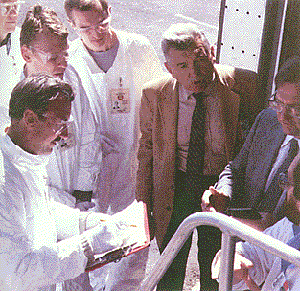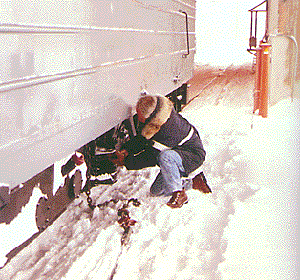| In late
July 1988, the USSR's portal monitoring building arrived
by air cargo from the Soviet Union. The building was a
group of four prefab modules that would be fitted
together at the site. It would become the Soviet Union's
data collection center. Also included in the cargo were
two small booths for monitoring road exits. The Soviet
buildings and booths were inspected by U.S. officials at
the airport, then transported to the Magna site. In early
October, they were placed on concrete foundations. The
U.S. escort team, assisted by the Soviet inspectors,
installed electrical wiring, backup electrical
generators, and treaty-authorized monitoring equipment.
By mid-October, the Soviet inspection team was monitoring
the traffic leaving the portal from their data collection
center. Other monitoring equipment--traffic lights, gate
switches, and closed-circuit television--were also
installed during the first treaty year. By agreement, the two inspection agencies determined that, the party being inspected would provide permanent housing for the portal monitoring inspectors within the first year. The inspecting party would pay for the housing, as required by the treaty, but it would be constructed by the inspected party. At Magna, U.S. officials offered the Soviet INF inspectors two choices for their permanent housing. The Soviets selected a five-acre site in West Jordan, Utah, a small town approximately eight miles southeast of Magna. In West Jordan, the U.S. government proposed to build a permanent apartment housing complex for the 30 Soviet inspectors, equipped with a clubhouse, swimming pool, spa, jogging path, and tennis court. It would cost $1.6 million. The Soviets agreed. Construction began in October 1988; as the work proceeded in the fall and winter months of 1988-89, Soviet team chiefs were briefed weekly on the construction status. They also made periodic escorted visits to the site. By the spring of 1989, the West Jordan housing complex had been completed. The Soviet inspection team moved into their new residences on April 18. Approximately two weeks earlier, the American inspectors at Votkinsk had moved into their permanent quarters.36 |
 At Magna, Soviet inspectors, dressed in special anti-static suits, examine a rocket motor product that had exited the plant. American linguist Orr Potebnya assists Robert Erickson and the Soviet inspectors in answering a question. |


